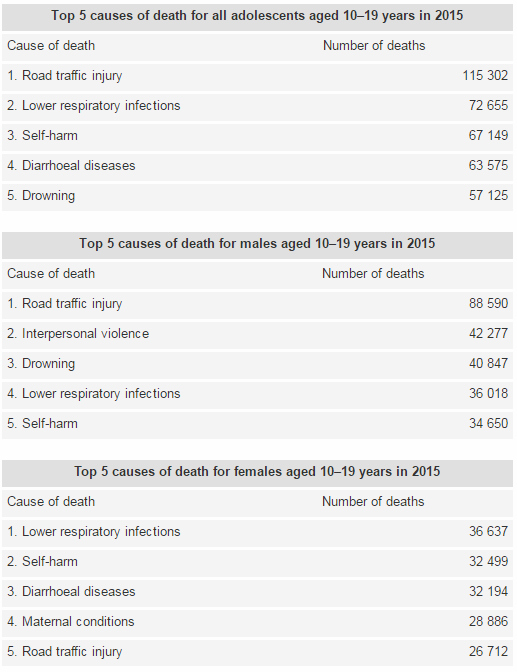More than 1.2 million adolescents die every year, nearly all preventable
WHO and partners recommend actions to improve adolescent health
More than 3000 adolescents die every day, totalling 1.2 million deaths a year, from largely preventable causes, according to a new report from WHO and partners. In 2015, more than two-thirds of these deaths occurred in low- and middle-income countries in Africa and South-East Asia. Road traffic injuries, lower respiratory infections, and suicide are the biggest causes of death among adolescents.
Most of these deaths can be prevented with good health services, education and social support. But in many cases, adolescents who suffer from mental health disorders, substance use, or poor nutrition cannot obtain critical prevention and care services – either because the services do not exist, or because they do not know about them.
In addition, many behaviours that impact health later in life, such as physical inactivity, poor diet, and risky sexual health behaviours, begin in adolescence.
"Adolescents have been entirely absent from national health plans for decades," says Dr Flavia Bustreo, Assistant Director-General, WHO. "Relatively small investments focused on adolescents now will not only result in healthy and empowered adults who thrive and contribute positively to their communities, but it will also result in healthier future generations, yielding enourmous returns."
Data in the report, Global accelerated action for the health of adolescents (AA-HA!): Guidance to support country implementation, reveal stark differences in causes of death when separating the adolescent group by age (younger adolescents aged 10–14 years and older ones aged 15–19 years) and by sex. The report also includes the range of interventions – from seat-belt laws to comprehensive sexuality education – that countries can take to improve their health and well-being and dramatically cut unnecessary deaths.
Road injuries top cause of death of adolescents, disproportionately affecting boys
In 2015, road injuries were the leading cause of adolescent death among 10–19-year-olds, resulting in approximately 115 000 adolescent deaths. Older adolescent boys aged 15–19 years experienced the greatest burden. Most young people killed in road crashes are vulnerable road users such as pedestrians, cyclists and motorcyclists.
However, differences between regions are stark. Looking only at low- and middle-income countries in Africa, communicable diseases such as HIV/AIDS, lower respiratory infections, meningitis, and diarrhoeal diseases are bigger causes of death among adolescents than road injuries.
Lower respiratory infections and pregnancy complications take toll on girls’ health
The picture for girls differs greatly. The leading cause of death for younger adolescent girls aged 10–14 years are lower respiratory infections, such as pneumonia – often a result of indoor air pollution from cooking with dirty fuels. Pregnancy complications, such as haemorrhage, sepsis, obstructed labour, and complications from unsafe abortions, are the top cause of death among 15–19-year-old girls.
Adolescents are at very high risk of self-harm and suicide
Suicide and accidental death from self-harm were the third cause of adolescent mortality in 2015, resulting in an estimated 67 000 deaths. Self-harm largely occurs among older adolescents, and globally it is the second leading cause of death for older adolescent girls. It is the leading or second cause of adolescent death in Europe and South-East Asia.
A vulnerable population in humanitarian and fragile settings
Adolescent health needs intensify in humanitarian and fragile settings. Young people often take on adult responsibilities, including caring for siblings or working, and may be compelled to drop out of school, marry early, or engage in transactional sex to meet their basic survival needs. As a result, they suffer malnutrition, unintentional injuries, pregnancies, diarrhoeal diseases, sexual violence, sexually-transmitted diseases, and mental health issues.
Interventions to improve adolescent health
"Improving the way health systems serve adolescents is just one part of improving their health," says Dr Anthony Costello, Director, Maternal, Newborn, Child and Adolescent Health, WHO. "Parents, families, and communities are extremely important, as they have the greatest potential to positively influence adolescent behaviour and health."
The AA-HA! Guidance recommends interventions across sectors, including comprehensive sexuality education in schools; higher age limits for alcohol consumption; mandating seat-belts and helmets through laws; reducing access to and misuse of firearms; reducing indoor air pollution through cleaner cooking fuels; and increasing access to safe water, sanitation, and hygiene. It also provides detailed explanations of how countries can deliver these interventions with adolescent health programmes.

Source: World Health Organization
- 307 reads
Human Rights
Ringing FOWPAL’s Peace Bell for the World:Nobel Peace Prize Laureates’ Visions and Actions

Protecting the World’s Cultural Diversity for a Sustainable Future

The Peace Bell Resonates at the 27th Eurasian Economic Summit

Declaration of World Day of the Power of Hope Endorsed by People in 158 Nations

Puppet Show I International Friendship Day 2020

